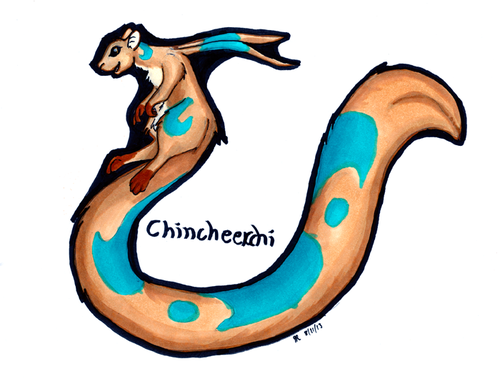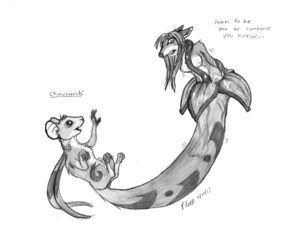Chincheerchi
Basic Info
Name: Chincheerchi Variant 3
Gender: Asexual
Classification: Sentient bioweapon.
Height: 4 ft tall
Tail Length: 8-12 ft
Purpose and Design
Chincheerchi is a creature designed by Plethorat as a superior predator to be mass produces in the interest of terminating all non-murine species. Version three comes with fifty percent less chance of attacking murine species as compared to earlier versions. However, terminated version three has been hampered by its escape.
Chincheerchi consists of two major segments: the lure and the tail. The lure appears to be a small, friendly creature with what might be two small, vestigial limbs on its back. While it appears to be a normal creature, the lure contains far fewer organs than it should in addition to be non-essential for the life of the organism. Able to speak and otherwise engage in conversation, the lure is meant to bring targets in close enough to be captured and consumed.
The tail is not a tail at all but is the true organism. It possesses a segmented anatomy including circulatory, nervous, and respiratory systems. The interior space contains eight powerful tentacles that can extend well beyond the opening at the tip of the tail with a ninth central tentacle that exudes a powerful narcotic that can be absorbed by the skin or from any interior surface of a meal, and this compound, or family of compounds, can subdue and even kill a target. By employing this method of capture, prey that is caught and slips away can he tracked as they succumb to the narcotics and then be re-acquired. Once inside, the prey is bound tightly and the Chincheerchi will seal it inside before wandering off to some quiet place to digest.
For those large enough to attack an adult Chincheerchi, they should beware that these organisms are terribly toxic. Ingesting the blood of a chincheerchi is can be lethal and at the very least debilitating. Chincheerchi were created with a nervous system capable of tolerating botulinum toxin along with the expression of the toxin as part of their blood serum.
Personality and Behavior
Chincheerchi are synthetic predators, and they possess all the confidence and instincts to back that up. Most Chincheerchi are very confident and quite methodical in their hunts. They can be gentle and they can be rough, but in the end it comes down to whether they are hungry or not. One might console someone and lure them into a sense of security that allows the Chincheerchi to gently and even tenderly ease them into eternal sleep while another might stalk a feisty meal for miles and risk injury for something a little more filling.
Overall Chincheerchi are friendly but should never be trusted. They were made to hunt, and even murine species cannot be certain of their safety even though Chincheerchi will take non-murine meals preferentially. They also like to play with their food. For the willing meals, this can be quite pleasant and drawn out, but for the rest of their prey, it can be terrifying though rarely painful unless the chincheerchi deems that its prey deserves such. Overall preferences lean towards quietly subduing their prey as not to draw attention from anyone that might interfere.
Life Cycle
While Chincheerchi are artificial organisms, they were created with a very robust means of surviving and expanding their numbers.
- Buds
- Chinni begin their lives as buds on the back of the lure. These buds will drop off the lure when large enough, usually a few feet long, and are capable of hunting small prey on their own including mice and insects. If left alone, they will slowly mature and rely on their toxic nature to protect them much like some caterpillars do. Should the adult be present, they will greatly accelerate the growth of the buds by feeding and protecting them. Each Chinni can produce two buds at a time, and new buds take about three to five months to regrow on the lure.
- Metamorphosis
- Like caterpillars, Chinni use a metamorphosis stage to change from a bud to an adult. Chinni will curl into a tight ball in a secluded space, and their fur will form toxic bristles as the external skin hardens to protect the bud during this phase which takes from three to five weeks depending on conditions including temperature. At this point, the bud is usually between six to eight feet long, and the chrysalis ball is usually around three to five feet wide. When the shell breaks, the Chinni will emerge with a lure and is now a miniature version of the full adult.
- Adult
- The young adult is more than capable of overpowering many average sized people, and their toxic and narcotic properties are sufficient to take down adult beings without much of a fight. They have to stretch more than older Chinni, but they can generally consume a normal adult being without leaving obvious evidence. Young adults take at least six if not twelve months before their lures begin to create new buds. This leaves the generation time somewhere between one and two years with a bias towards the latter.
Regeneration and Healing
- Adults
- Adults can often heal wounds with no apparent scar, but they heal at a fairly standard rate for mammals despite their unusual makeup. However, if a lure is lost or too damage to heal, the adult cannot regenerate a new lure.
- Immature Chinni
- Chinni buds can heal quickly from wounds that might be lethal to a comparably sized organism because of their segmented nature. As long as they are not extremely damaged, Chinni buds that make it to the metamorphosis stage can grow through almost any damage done to them prior.
- Detached Lures
- When a CHinni is injured enough, it will often split the lure from the tail. The lure is capable of surviving for a week without the tail provided it can find water. Without water, it will have only two to three days of activity. The lure will try to find a place to hide, and if it has buds, it will release them before moving on in order to lure potential pursuers away from their den. Lures have limited ability to digest food and will waste away after being lost. They are still sentient and independent, and the only thing worse than finding a lure alone is finding one with two bud scars on its back.
Nervous System and Intelligence
Chinni effectively have two centers of intelligence as an adult. The lure has a fully developed brain comparable to most sentient species that allows for thinking, conversation, and all the finer aspects of deception. The tail has a simpler, segmented nervous system that still has a mass and organization much greater than any arthropod would. The tail should be considered nearly as clever as the lure, and doubly so when it comes to hunting and basic survival. The two major thinking systems were made to operate cooperatively rather than battling with each other, but if one could read the minds of the Chinni, they would be able to spot the higher thinking in the lure and the clever but more primal aspects of the tail.
Lure Protection
Because the lure is critical to reproduction, and because it is rightly named for its ability to draw prey in close, Chinni will defend their lure using their tail when needed. This also makes it look like the tail is less important and that the lure is in charge. A Chinni actively protecting its lure should be considered extremely dangerous. Not only may it be overly aggressive, but it will be more likely to cause lure release prior to going into direct combat.

